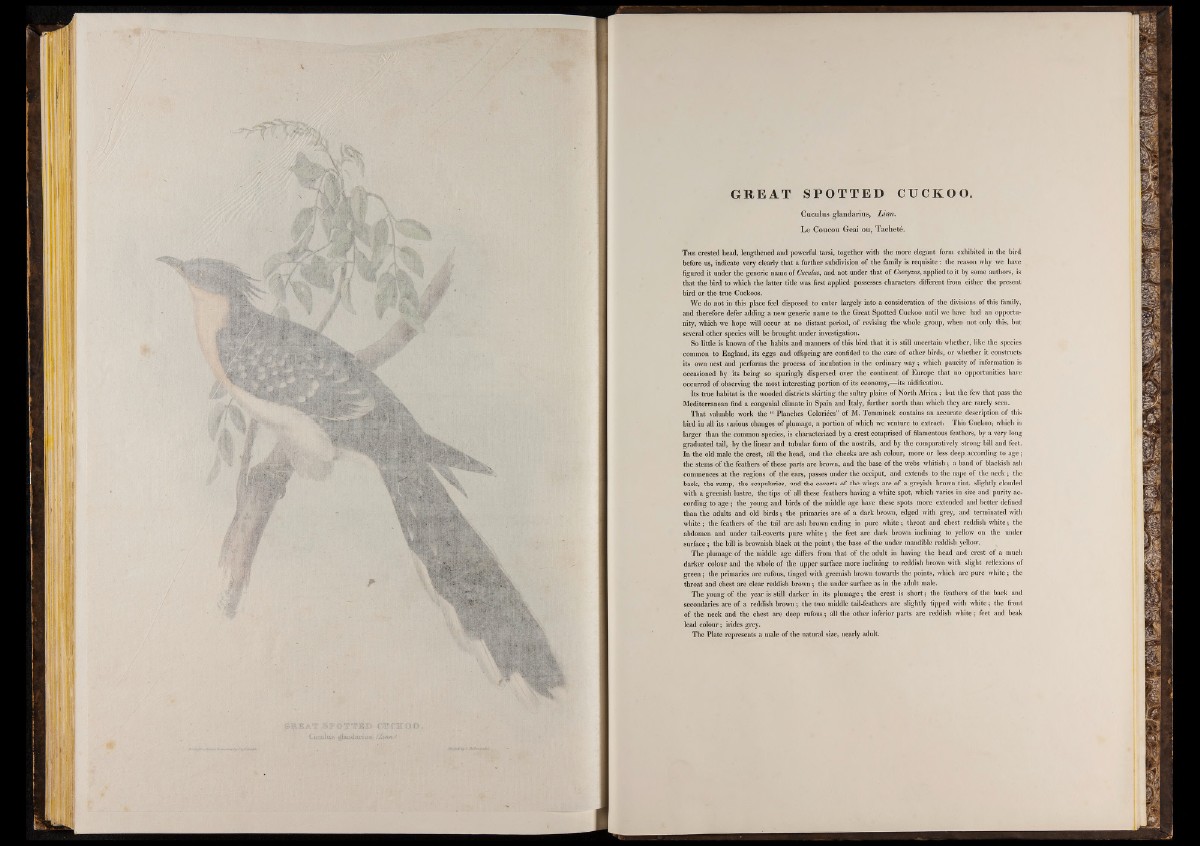
G R E A T S P O T T E D CUCKOO.
C u c u lu s g lan d a riu s , Linn.
L e Co u co u Geai o u , T ach eté.
T he crested head, lengthened and powerful tarsi, together with the more elegant form exhibited in the bird
before us, indicate very clearly that a further subdivision of the family is requisite : the reason why we have
figured it under the generic name o f Cuculus, and not under that of Coccyzus, applied to it by some authors, is
that the bird to which the latter title was first applied possesses characters different from either the present
bird or the true Cuckoos.
We do not in this place feel disposed to enter largely into a consideration o f the divisions of this family,
and therefore defer adding a new generic name to the Great Spotted Cuckoo until we have had an opportunity,
which we hope will occur at no distant period, of revising the whole group, when not only this, but
several other species will be brought under investigation.
So little is known o f the habits and manners of this bird that it is still uncertain whether, like the species
common to England, its eggs and offspring are confided to the care of other birds, or whether it constructs
its own nest and performs the process of incubation in the ordinary way ; which paucity of information is
occasioned by its being so sparingly dispersed over the continent of Europe that no opportunities have
occurred of observing the most interesting portion of its economy,— its nidification.
Its true habitat is the wooded districts skirting the sultry plains o f North Africa ; but the few that pass the
Mediterranean find a congenial climate in Spain and Italy, further north than which they are rarely seen.
That valuable work the “ Planches Coloriées” of M. Temminck contains an accurate description of this
bird in all its various changes of plumage, a portion of which we venture to extract. This Cuckoo, which is
larger than the common species, is characterized by a crest comprised of filamentous feathers, by a very long
graduated tail, by the linear and tubular form of the nostrils, and by the comparatively strong bill and feet.
In the old male the crest, all the head, and the cheeks are ash colour, more or less deep.according to age ;
the stems of the feathers of these parts are brown, and the base of the webs whitish ; a band of blackish ash
commences at the regions o f the ears, passes under the occiput, and extends to the nape of the neck ; the
back, the rump, the scapularies, and the coverts o f the wings are of a greyish brown tint, slightly clouded
with a greenish lustre, the tips of all these feathers having a white spot, which varies in size and purity according
to age ; the young and birds of the middle age have these spots more extended and better defined
than the adults and old birds ; the primaries are of a dark brown, edged with grey, and terminated with
white ; the feathers of the tail are ash brown ending in pure white ; throat and chest reddish white ; the
abdomen and under tail-coverts pure white ; the feet are dark brown inclining to yellow on the under
surface ; the bill is brownish black at the point ; the base of the under mandible reddish yellow.
The plumage of the middle age differs from that of the adult in having the head and crest of a much
darker colour and the whole of the upper surface more inclining to reddish brown with slight reflexions of
green ; the primaries are rufous, tinged with greenish brown towards the points, which are pure white ; the
throat and chest are clear reddish brown ; the under surface as in the adult male.
The young of the year is still darker in its plumage ; the crest is short ; the feathers of the back and
secondàries are of a reddish brown ; the two middle tail-feathers are slightly tipped with white ; the front
o f the neck and the chest are deep rufous ; all the other inferior parts are reddish white ; feet and beak
lead colour ; irides grey.
The Plate represents a male of the natural size, nearly adult.